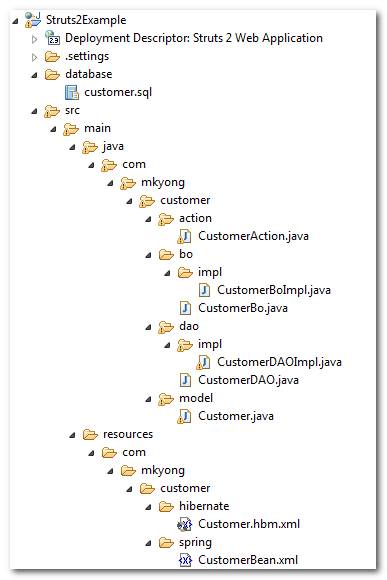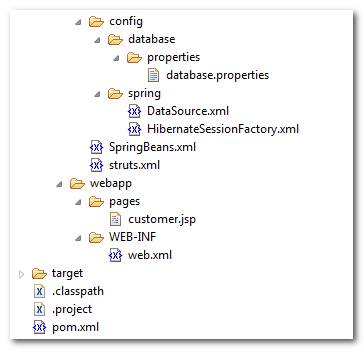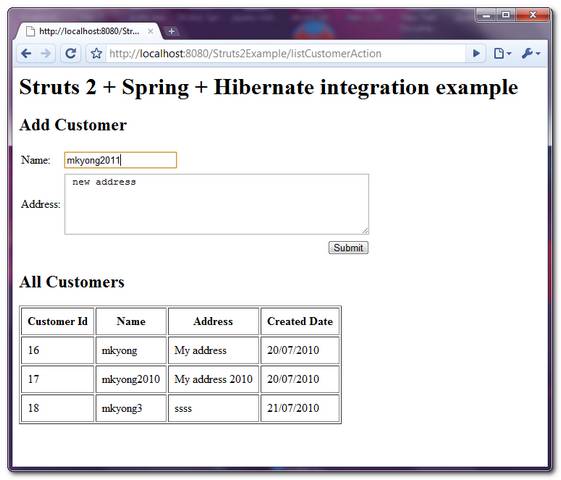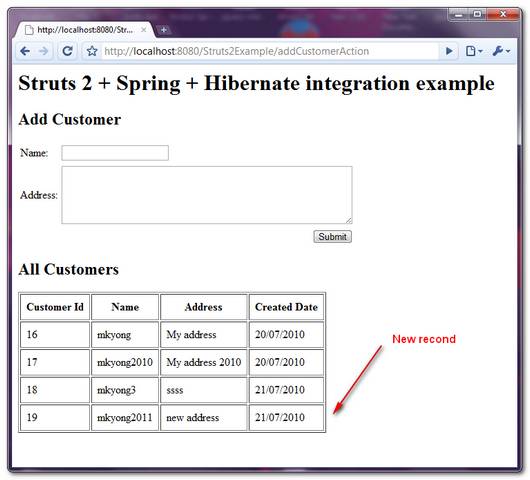Struts 2 + Spring + Hibernate integration Tutorial
来源:互联网 发布:谷歌关键词优化 编辑:程序博客网 时间:2024/04/30 13:22
In this tutorial, it shows the integration between “Struts2 + Spring + Hibernate“. Make sure you check the following tutorials before continue.
- Struts 2 + Hibernate integration example
- Struts 2 + Spring integration example
- Struts 1.x + Spring + Hibernate integration example
See the summary of integration steps :
- Get all the dependency libraries (a lot).
- Register Spring’s ContextLoaderListener to integrate Struts 2 and Spring.
- Use Spring’s LocalSessionFactoryBean to integrate Spring and Hibernate.
- Done, all connected.
See the relationship :
Struts 2 <-- (ContextLoaderListener) --> Spring <-- (LocalSessionFactoryBean) --> Hibernate
Tutorials Start…
It will going to create a customer page, with add customer and list customer function. Front end is usingStruts 2 to display,Spring as the dependency injection engine, andHibernate to doing the database operation. Let start…
1. Project structure
Project folder structure.


2. MySQL table script
Customer’s table script.
DROP TABLE IF EXISTS `mkyong`.`customer`;CREATE TABLE `mkyong`.`customer` ( `CUSTOMER_ID` BIGINT(20) UNSIGNED NOT NULL AUTO_INCREMENT, `NAME` VARCHAR(45) NOT NULL, `ADDRESS` VARCHAR(255) NOT NULL, `CREATED_DATE` datetime NOT NULL, PRIMARY KEY (`CUSTOMER_ID`)) ENGINE=InnoDB AUTO_INCREMENT=17 DEFAULT CHARSET=utf8;
3.Dependency libraries
This tutorials request many dependency libraries.
Struts 2…
<!-- Struts 2 --> <dependency> <groupId>org.apache.struts</groupId> <artifactId>struts2-core</artifactId> <version>2.1.8</version> </dependency><!-- Struts 2 + Spring plugins --><dependency> <groupId>org.apache.struts</groupId> <artifactId>struts2-spring-plugin</artifactId> <version>2.1.8</version> </dependency>
MySQL…
<!-- MySQL database driver --><dependency><groupId>mysql</groupId><artifactId>mysql-connector-java</artifactId><version>5.1.9</version></dependency>
Spring…
<!-- Spring framework --> <dependency><groupId>org.springframework</groupId><artifactId>spring</artifactId><version>2.5.6</version></dependency><dependency><groupId>org.springframework</groupId><artifactId>spring-web</artifactId><version>2.5.6</version></dependency>
Hibernate…
<!-- Hibernate core --><dependency><groupId>org.hibernate</groupId><artifactId>hibernate</artifactId><version>3.2.7.ga</version></dependency> <!-- Hibernate core library dependency start --><dependency><groupId>dom4j</groupId><artifactId>dom4j</artifactId><version>1.6.1</version></dependency> <dependency><groupId>commons-logging</groupId><artifactId>commons-logging</artifactId><version>1.1.1</version></dependency> <dependency><groupId>commons-collections</groupId><artifactId>commons-collections</artifactId><version>3.2.1</version></dependency> <dependency><groupId>cglib</groupId><artifactId>cglib</artifactId><version>2.2</version></dependency><!-- Hibernate core library dependency end --> <!-- Hibernate query library dependency start --><dependency><groupId>antlr</groupId><artifactId>antlr</artifactId><version>2.7.7</version></dependency><!-- Hibernate query library dependency end -->
4. Hibernate…
Only the model and mapping files are required, because Spring will handle the Hibernate configuration.
Customer.java – Create a class for customer table.
package com.mkyong.customer.model; import java.util.Date; public class Customer implements java.io.Serializable { private Long customerId;private String name;private String address;private Date createdDate; //getter and setter methods}
Customer.hbm.xml – Hibernate mapping file for customer.
<?xml version="1.0"?><!DOCTYPE hibernate-mapping PUBLIC "-//Hibernate/Hibernate Mapping DTD 3.0//EN""http://hibernate.sourceforge.net/hibernate-mapping-3.0.dtd"><!-- Generated 20 Julai 2010 11:40:18 AM by Hibernate Tools 3.2.5.Beta --><hibernate-mapping> <class name="com.mkyong.customer.model.Customer" table="customer" catalog="mkyong"> <id name="customerId" type="java.lang.Long"> <column name="CUSTOMER_ID" /> <generator class="identity" /> </id> <property name="name" type="string"> <column name="NAME" length="45" not-null="true" /> </property> <property name="address" type="string"> <column name="ADDRESS" not-null="true" /> </property> <property name="createdDate" type="timestamp"> <column name="CREATED_DATE" length="19" not-null="true" /> </property> </class></hibernate-mapping>
5. Struts 2…
Implements the Bo and DAO design pattern. All the Bo and DAO will be DI by Spring in the Spring bean configuration file. In the DAO, make it extends Spring’sHibernateDaoSupport to integrate Spring and Hibernate integration.
CustomerBo.java
package com.mkyong.customer.bo; import java.util.List;import com.mkyong.customer.model.Customer; public interface CustomerBo{ void addCustomer(Customer customer);List<Customer> listCustomer(); }
CustomerBoImpl.java
package com.mkyong.customer.bo.impl; import java.util.List;import com.mkyong.customer.bo.CustomerBo;import com.mkyong.customer.dao.CustomerDAO;import com.mkyong.customer.model.Customer; public class CustomerBoImpl implements CustomerBo{ CustomerDAO customerDAO;//DI via Springpublic void setCustomerDAO(CustomerDAO customerDAO) {this.customerDAO = customerDAO;} //call DAO to save customerpublic void addCustomer(Customer customer){customerDAO.addCustomer(customer);} //call DAO to return customerspublic List<Customer> listCustomer(){return customerDAO.listCustomer();}}
CustomerDAO.java
package com.mkyong.customer.dao; import java.util.List;import com.mkyong.customer.model.Customer; public interface CustomerDAO{ void addCustomer(Customer customer);List<Customer> listCustomer(); }
CustomerDAOImpl.java
package com.mkyong.customer.dao.impl; import java.util.List;import org.springframework.orm.hibernate3.support.HibernateDaoSupport;import com.mkyong.customer.dao.CustomerDAO;import com.mkyong.customer.model.Customer; public class CustomerDAOImpl extends HibernateDaoSupport implements CustomerDAO{ //add the customerpublic void addCustomer(Customer customer){getHibernateTemplate().save(customer);} //return all the customers in listpublic List<Customer> listCustomer(){return getHibernateTemplate().find("from Customer");} }
CustomerAction.java – The Struts2 action is no longer need to extends theActionSupport, Spring will handle it.
package com.mkyong.customer.action; import java.util.ArrayList;import java.util.Date;import java.util.List; import com.mkyong.customer.bo.CustomerBo;import com.mkyong.customer.model.Customer;import com.opensymphony.xwork2.ModelDriven; public class CustomerAction implements ModelDriven{ Customer customer = new Customer();List<Customer> customerList = new ArrayList<Customer>(); CustomerBo customerBo;//DI via Springpublic void setCustomerBo(CustomerBo customerBo) {this.customerBo = customerBo;} public Object getModel() {return customer;} public List<Customer> getCustomerList() {return customerList;} public void setCustomerList(List<Customer> customerList) {this.customerList = customerList;} //save customerpublic String addCustomer() throws Exception{ //save itcustomer.setCreatedDate(new Date());customerBo.addCustomer(customer); //reload the customer listcustomerList = null;customerList = customerBo.listCustomer(); return "success"; } //list all customerspublic String listCustomer() throws Exception{ customerList = customerBo.listCustomer(); return "success"; } }
6. Spring…
Almost all the configuration is done here, at all, Spring is specialized in integration work :).
CustomerBean.xml – Declare the Spring’s beans : Action, BO and DAO.
<?xml version="1.0" encoding="UTF-8"?><beans xmlns="http://www.springframework.org/schema/beans"xmlns:xsi="http://www.w3.org/2001/XMLSchema-instance"xsi:schemaLocation="http://www.springframework.org/schema/beans http://www.springframework.org/schema/beans/spring-beans-2.5.xsd"> <bean id="customerAction" class="com.mkyong.customer.action.CustomerAction"><property name="customerBo" ref="customerBo" /></bean> <bean id="customerBo" class="com.mkyong.customer.bo.impl.CustomerBoImpl" ><property name="customerDAO" ref="customerDAO" /></bean> <bean id="customerDAO" class="com.mkyong.customer.dao.impl.CustomerDAOImpl" ><property name="sessionFactory" ref="sessionFactory" /></bean> </beans>
database.properties – Declare the database details.
jdbc.driverClassName=com.mysql.jdbc.Driverjdbc.url=jdbc:mysql://localhost:3306/mkyongjdbc.username=rootjdbc.password=password
DataSource.xml – Create a datasource bean.
<beans xmlns="http://www.springframework.org/schema/beans"xmlns:xsi="http://www.w3.org/2001/XMLSchema-instance"xsi:schemaLocation="http://www.springframework.org/schema/beanshttp://www.springframework.org/schema/beans/spring-beans-2.5.xsd"> <bean class="org.springframework.beans.factory.config.PropertyPlaceholderConfigurer"> <property name="location"> <value>WEB-INF/classes/config/database/properties/database.properties</value> </property></bean> <bean id="dataSource" class="org.springframework.jdbc.datasource.DriverManagerDataSource"><property name="driverClassName" value="${jdbc.driverClassName}" /><property name="url" value="${jdbc.url}" /><property name="username" value="${jdbc.username}" /><property name="password" value="${jdbc.password}" /> </bean> </beans>
HibernateSessionFactory.xml – Create a sessionFactory bean to integrate Spring and Hibernate.
<?xml version="1.0" encoding="UTF-8"?><beans xmlns="http://www.springframework.org/schema/beans"xmlns:xsi="http://www.w3.org/2001/XMLSchema-instance"xsi:schemaLocation="http://www.springframework.org/schema/beanshttp://www.springframework.org/schema/beans/spring-beans-2.5.xsd"> <!-- Hibernate session factory --><bean id="sessionFactory" class="org.springframework.orm.hibernate3.LocalSessionFactoryBean"> <property name="dataSource"> <ref bean="dataSource"/> </property> <property name="hibernateProperties"> <props> <prop key="hibernate.dialect">org.hibernate.dialect.MySQLDialect</prop> <prop key="hibernate.show_sql">true</prop> </props> </property> <property name="mappingResources"><list> <value>com/mkyong/customer/hibernate/Customer.hbm.xml</value></list> </property> </bean></beans>
SpringBeans.xml – Create a core Spring’s bean configuration file, act as the central bean management.
<beans xmlns="http://www.springframework.org/schema/beans"xmlns:xsi="http://www.w3.org/2001/XMLSchema-instance"xsi:schemaLocation="http://www.springframework.org/schema/beanshttp://www.springframework.org/schema/beans/spring-beans-2.5.xsd"> <!-- Database Configuration --><import resource="config/spring/DataSource.xml"/><import resource="config/spring/HibernateSessionFactory.xml"/> <!-- Beans Declaration --><import resource="com/mkyong/customer/spring/CustomerBean.xml"/> </beans>
7. JSP page
JSP page to display the element with Struts 2 tags.
customer.jsp
<%@ taglib prefix="s" uri="/struts-tags" %><html><head></head> <body><h1>Struts 2 + Spring + Hibernate integration example</h1> <h2>Add Customer</h2><s:form action="addCustomerAction" > <s:textfield name="name" label="Name" value="" /> <s:textarea name="address" label="Address" value="" cols="50" rows="5" /> <s:submit /></s:form> <h2>All Customers</h2> <s:if test="customerList.size() > 0"><table border="1px" cellpadding="8px"><tr><th>Customer Id</th><th>Name</th><th>Address</th><th>Created Date</th></tr><s:iterator value="customerList" status="userStatus"><tr><td><s:property value="customerId" /></td><td><s:property value="name" /></td><td><s:property value="address" /></td><td><s:date name="createdDate" format="dd/MM/yyyy" /></td></tr></s:iterator></table></s:if><br/><br/> </body></html>
8. struts.xml
Link it all ~
<?xml version="1.0" encoding="UTF-8" ?><!DOCTYPE struts PUBLIC"-//Apache Software Foundation//DTD Struts Configuration 2.0//EN""http://struts.apache.org/dtds/struts-2.0.dtd"> <struts> <constant name="struts.devMode" value="true" /> <package name="default" namespace="/" extends="struts-default"> <action name="addCustomerAction" class="customerAction" method="addCustomer" > <result name="success">pages/customer.jsp</result></action> <action name="listCustomerAction"class="customerAction" method="listCustomer" > <result name="success">pages/customer.jsp</result></action> </package> </struts>
9. Struts 2 + Spring
To integrate Struts 2 and Spring, just register the ContextLoaderListener listener class, define a “contextConfigLocation” parameter to ask Spring container to parse the “SpringBeans.xml” instead of the default “applicationContext.xml“.
web.xml
<!DOCTYPE web-app PUBLIC "-//Sun Microsystems, Inc.//DTD Web Application 2.3//EN" "http://java.sun.com/dtd/web-app_2_3.dtd" > <web-app> <display-name>Struts 2 Web Application</display-name> <filter><filter-name>struts2</filter-name><filter-class> org.apache.struts2.dispatcher.ng.filter.StrutsPrepareAndExecuteFilter</filter-class> </filter> <filter-mapping><filter-name>struts2</filter-name><url-pattern>/*</url-pattern> </filter-mapping> <context-param><param-name>contextConfigLocation</param-name><param-value>/WEB-INF/classes/SpringBeans.xml</param-value> </context-param> <listener> <listener-class> org.springframework.web.context.ContextLoaderListener </listener-class> </listener> </web-app>
10. Demo
Test it : http://localhost:8080/Struts2Example/listCustomerAction.action


Reference
- Struts 2 + Hibernate integration example
- Struts 2 + Spring integration example
- Struts 2 + Hibernate example with Full Hibernate Plugin
- Struts 1.x + Spring + Hibernate integration example
- Struts 2 + Spring + Hibernate integration Tutorial
- Struts Hibernate Integration Tutorial
- Struts 2 + Spring + Hibernate integration example
- Struts + Spring + Hibernate integration example
- Spring, Hibernate, Maven, and Struts2 integration tutorial
- Struts 2 and Hibernate Integration
- Struts 2 and Spring Integration
- Spring and Hibernate Integration Part 2
- Hibernate and Spring Integration
- Spring 4 and Hibernate 4 integration tutorial part 1 xml configuration
- spring+hibernate+struts(2)
- MyBatis 3 – Spring integration tutorial
- Spring/Activiti/JPA(Hibernate) Integration
- Struts 2 + Spring + Hibernate 集成
- Struts 2 :spring: hibernate 网址?
- FATAL ERROR STARTING UP STRUTS-SPRING INTEGRATION
- struts spring integration and test using junit4
- Struts+Hibernate+Spring学习心得(2)Hibernate
- Virtual Ubuntu Resolution Settings
- MapReduce 模式、算法和用例
- myeclipse 启动服务时 提示“Address already in use:JVM_Bind:8080”
- 设备驱动学习之字符设备驱动内核代码分析(二)——字符设备结构体cdev
- 返回顶部
- Struts 2 + Spring + Hibernate integration Tutorial
- 将文件上传、下载(以二进制流保存到数据库)
- MapReduce算法设计--Think in Hadoop
- Share some tips about android develop(一)
- ora-00604,ora-00942
- Machine Learning(三)(逻辑回归Logistical Regression)
- MapReduce算法模式
- Java高级特性之反射(流行框架都用到)
- 1.1、Activity的生命周期


